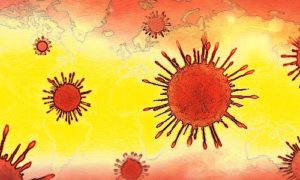US Centres for Disease Control and Prevention (CDC) has announced that COVID-19 can spread through virus lingering in the air, sometimes for hours, acknowledging concerns widely voiced by public health experts about airborne transmission of the virus, Reuters reports.
While CDC stresses close-contact transmission is more common than through air, a group of US scientists at the University of California-San Diego, Virginia Tech, University of Maryland School of Medicine, University of California-San Francisco, and Harvard TH Chan School of Public Health, warned in an unrelated published open letter that aerosols lingering in the air could be a major source of COVID-19 transmission.
“The reality is airborne transmission is the main way that transmission happens at close range with prolonged contact,” the researchers said in a press call.
Viruses in aerosols can remain in the air for seconds to hours, travel more than two meters and accumulate in poorly ventilated indoor air, leading to superspreading events, the researchers said. Since individuals with COVID-19 release thousands of virus-laden aerosols and far fewer droplets while breathing and talking, the scientists said the focus must be on protecting against airborne transmission.
They also said that public health officials should clearly differentiate between droplets ejected by coughing or sneezing and aerosols that can carry the virus to greater distances
Public health officials must highlight the importance of moving activities outdoors and improving indoor air, along with wearing mask and social distancing, the letter said.
The letter from leading researchers urges terminology update, shift in COVID-19 guidance.
Scientists affiliated with leading research institutions across the US state in a letter that researchers across disciplines must converge to deliver clear public health guidance about how SARS-CoV-2 is spread in the air.
The researchers write in the open letter that the scientific community must clarify the terminology used related to aerosols and droplets, and employ a more modern size threshold, rather than the existing one based on 1930s-era work. Authors include experts from the University of California-San Diego, University of Maryland, Virginia Tech, and others.
Public health officials should make a clear distinction between droplets ejected by coughing or sneezing – which have inspired the social distancing mantra of six feet of separation between people – and aerosols that can carry the virus for much greater distances. Viruses in aerosols smaller than 100 microns can remain airborne in a confined space for prolonged periods of time, and accumulate in poorly ventilated air, leading to transmission.
"The balance of attention must be shifted to protecting against airborne transmission," said the group, led by Kimberly Prather, director of the National Science Foundation-funded Centre for Aerosol Impacts on Chemistry of the Environment based at Scripps Institution of Oceanography at UC San Diego.
"Viruses in aerosols can remain suspended in air for many seconds to hours, like smoke, and be inhaled," according to the letter. "They are highly concentrated near an infected person, so they can infect people most easily in close proximity. But aerosols containing infectious virus can also travel more than (two meters) and accumulate in poorly ventilated indoor air, leading to superspreading events."
In addition to mask wearing, social distancing and hygiene efforts, the researchers urge for public health officials to articulate the importance of moving activities outdoors, improving indoor air using ventilation and filtration, and improving protection for high risk workers.
"The goal of this letter is to make it clear that the SARS-Cov-2 virus travels in the air and people can become infected via inhalation," said Prather, a distinguished professor who holds a joint appointment between UC San Diego's Scripps Institution of Oceanography and its department of chemistry and biochemistry. "It is important to acknowledge this pathway so efforts can focus on cleaning the air and providing guidance on how to avoid risky indoor settings."
Co-author Linsey Marr, the Charles P Lunsford professor of civil and environmental engineering at Virginia Tech and an expert on airborne transmission of viruses, added, "It is important for people to wear masks at all times in public buildings and confined spaces, not only when we can't maintain social distance. This isn't just an academic question, but a point that will help reduce transmission if public health officials offer clear and forceful guidance about this."
Along with Prather and Marr, letter authors include physicians Robert Schooley of UC San Diego School of Medicine, Melissa McDiarmid and Donald Milton of the University of Maryland, and Mary Wilson of the University of California, San Francisco School of Medicine and Harvard TH Chan School of Public Health.
Letter authors
Kimberly A Prather, Linsey C Marr, Robert T Schooley, Melissa A McDiarmid, Mary E Wilson, Donald K Milton
[link url="https://uk.reuters.com/article/us-health-coronavirus-cdc-airborne/covid-19-could-spread-by-airborne-transmission-cdc-idUKKBN26Q2QI"]Full Reuters report[/link]
[link url="https://ucsdnews.ucsd.edu/pressrelease/letter-from-leading-researchers-urges-terminology-update-shift-in-covid-19-guidance"]University of California-San Diego material[/link]
[link url="https://science.sciencemag.org/content/early/2020/10/02/science.abf0521/tab-pdf"]Science letter[/link]
[link url="https://www.cdc.gov/coronavirus/2019-ncov/prevent-getting-sick/how-covid-spreads.html"]CDC Guidance Update[/link

